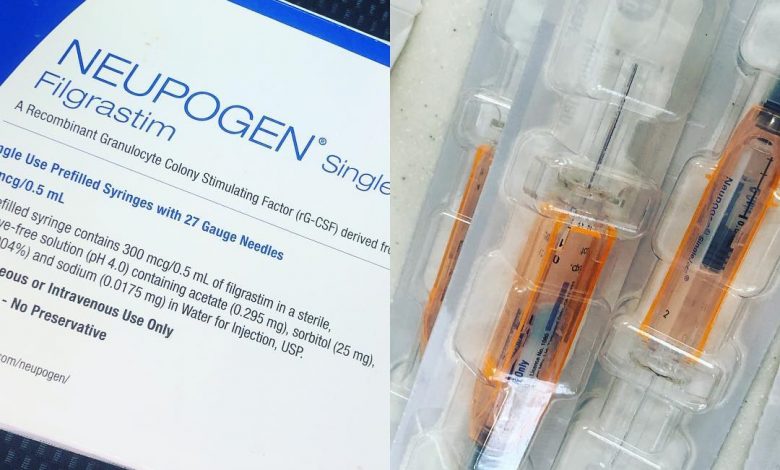How To Give Filgrastim (Granix, Neupogen, Nivestym, Zarxio) Injection

Filgrastim injection products (Granix, Neupogen, Nivestym, Zarxio) are used to decrease the chance of infection in people who have non-myeloid cancer (cancer that does not involve the bone marrow) and are receiving chemotherapy medications that may decrease the number of neutrophils (a type of blood cell needed to fight infection). Filgrastim injection products (Neupogen, Nivestym, Zarxio) are also used to help increase the number of white blood cells and decrease the length of time with fever in people with acute myeloid leukemia (AML; a type of cancer of the white blood cells) who are receiving treatment with chemotherapy medications.
Filgrastim injection products (Neupogen, Nivestym, Zarxio) are also used in people who are undergoing bone marrow transplants, in people who have severe chronic neutropenia (a condition in which there are a low number of neutrophils in the blood), and to prepare the blood for leukapheresis (a treatment in which certain blood cells are removed from the body.
Filgrastim injection (Neupogen) is also used to increase the chance of survival in people who have been exposed to harmful amounts of radiation, which can cause severe and life-threatening damage to your bone marrow. Filgrastim is in a class of medications called colony-stimulating factors. It works by helping the body make more neutrophils.
Dosing
The dose of this medicine will be different for different patients. Follow your doctor’s orders or the directions on the label. The following information includes only the average doses of this medicine. If your dose is different, do not change it unless your doctor tells you to do so.
The amount of medicine that you take depends on the strength of the medicine. Also, the number of doses you take each day, the time allowed between doses, and the length of time you take the medicine depend on the medical problem for which you are using the medicine.
• For injectable dosage form:
o For neutropenia:
- Adults and children—Dose is based on body weight and must be determined by your doctor. The dose is usually 5 to 10 microgram per kilogram (mcg/kg) of body weight injected under the skin per day. Your doctor may adjust your dose as needed.
- Infants younger than 1 month of age—Use and dose must be determined by your doctor.
Missed Dose
This medicine needs to be given on a fixed schedule. If you miss a dose or forget to use your medicine, call your doctor or pharmacist for instructions.
How To Give Yourself a Filgrastim (Granix, Neupogen, Nivestym, Zarxio) Injection
Filgrastim injection products come as a solution (liquid) in vials and prefilled syringes to inject under the skin or into a vein. It is usually given once a day, but filgrastim injection products (Neupogen, Nivestym, Zarxio) may be given twice a day when it is used to treat severe chronic neutropenia. The length of your treatment depends on the condition that you have and how well your body responds to the medication.
If you are using filgrastim injection products to decrease the risk of infection, decrease the time with fever, or increase the number of white blood cells during chemotherapy, you will receive your first dose of the medication at least 24 hours after you receive a dose of chemotherapy and will continue to receive the medication every day for up to 2 weeks or until your blood cell counts return to normal. If you are using filgrastim injection products to decrease the risk of infection during a bone marrow transplant, you will receive the medication at least 24 hours after you receive chemotherapy and at least 24 hours after the bone marrow is infused. If you are using filgrastim injection products to prepare your blood for leukapheresis, you will receive your first dose at least 4 days before the first leukapheresis and will continue to receive the medication until the last leukapheresis. If you are using filgrastim injection products to treat severe chronic neutropenia, you may need to use the medication for a long period of time. If you are using filgrastim injection because you have been exposed to harmful amounts of radiation, your doctor will monitor you carefully and the length of your treatment will depend on how well your body responds to the medication. Do not stop using filgrastim injection products without talking to your doctor.
Filgrastim injection products may be given to you by a nurse or other healthcare provider, or you may be told to inject the medication under the skin at home. If you or a caregiver will be injecting filgrastim injection products at home, a healthcare provider will show you or your caregiver how to inject the medication. Be sure that you understand these directions. Ask your healthcare provider if you have any questions. Use filgrastim injection products exactly as directed. Do not use more or less of it or use it more often than prescribed by your doctor.
Here is how to give yourself the injection:
Gather your supplies
Place your supplies on a clean, flat surface (such as a table or countertop). You can work in your bathroom if it is private and there is enough space. You will need:
• 1 prefilled syringe with a plastic safety guard attached
• 1 alcohol pad
• An empty, hard plastic container with a screw-top lid (such as a laundry detergent bottle) to throw away the syringe. For instructions on how to choose a plastic container, read How to Store and Get Rid of Your Home Medical Sharps.
• 1 (2-inch x 2-inch) gauze pad or cotton ball
• 1 bandage (such as a Band-Aid®)
Get the injection ready
1. Take the prefilled syringe out of your refrigerator 30 minutes before you plan to give yourself the injection. The medication should be at room temperature when you inject it.
2. Do not shake the syringe. Shaking it may damage the medication inside. If it has been shaken, the medication might look foamy and you should not use it.
3. Check the medication for the following:
o Name – Make sure the name of the medication matches what your healthcare provider prescribed for you. The name is listed on the package or syringe label.
o Expiration date – Make sure the expiration date on the syringe has not passed. If the date has passed, throw away the syringe in the plastic container.
o Dose – Make sure the dose of the medication matches what your healthcare provider prescribed for you. The dose is listed on the colored dot on the package.
o Color – Make sure the medication in the syringe is clear and colorless. Do not use it if it looks foamy, cloudy, has any color, or has crystals (solid pieces) in it.
Do not use the syringe if:
• The medication name or dose does not match what your healthcare provider prescribed.
• The medication is expired.
• The medication is foamy, cloudy, has any color, or has crystals (solid pieces) in it.
If you have another syringe, use that one instead. Then contact your healthcare provider or pharmacist to tell them what happened. You may be able to bring the unused syringe to your local pharmacy so they can replace it.
Choose an injection site
4. Choose an injection site (place on your body to give the injection) where you can pinch a 1 to 2-inch (2.5 to 5-centimeter) fold of skin. It is best to use one of the following areas :
o The front part of your upper arms
o Your abdomen (belly), except for the 2-inch (5-centimeter) area around your belly button
o The middle front or middle outside of your thighs
o The upper areas of your buttocks (butt), only if someone else is giving you the injection
o The back part of your upper arms, only if someone else is giving you the injection
Choose a different injection site each time. It is helpful to use a notebook or calendar to keep track. Switching injection sites will help limit soreness and keep scar tissue from forming. Scar tissue can keep the medication from working like it is supposed to. It also makes it hard to put the needle into your skin.
Do not inject into an area that is tender, red, bruised, hard, or that has scars or stretch marks.
5. Fold back any clothing covering the injection site.
6. Tear off any 3 edges on a sealed alcohol pad packet. Hold the packet at the edge you did not tear off. Carefully open the packet to expose the alcohol pad, but do not take the pad out. Set the open packet on your clean work area. You will use this alcohol pad to clean the skin at the injection site just before you give yourself the injection.
Give yourself the injection
It is best to give yourself the injection while standing up. If you are sitting or lying down, it may be hard to see the injection site. If you are more comfortable sitting or lying down, ask someone else to give you the injection, such as a caregiver. Make sure your healthcare provider shows this person how to give you the injection.
7. Wash your hands well with soap and water or use an alcohol-based hand sanitizer.
o If you are washing your hands with soap and water, wet your hands with warm water and apply soap. Rub your hands together for at least 20 seconds, then rinse. Dry your hands with a paper towel. Use that same towel to turn off the faucet.
o If you are using an alcohol-based hand sanitizer, be sure to cover all parts of your hands with it. Rub your hands together until they are dry.
8. Take the syringe out of its package.
Remove the needle cover
9. With your dominant hand (the hand you write with), hold the syringe around the middle, like a pen or dart. Carefully pull the needle cover straight off and throw it away in the plastic container. Once the needle cover is off, do not set the syringe down. Do not let anything, including your fingers, touch the needle. If anything touches the needle, throw away the syringe in the plastic container. Start over with a new syringe. After you give yourself the injection, contact your healthcare provider to tell them what happened.
10. Check the syringe for air bubbles. If you see any, hold the syringe with the needle pointing up. Gently tap the side of the syringe with your fingers until the air bubbles rise to the top, near the needle. Slowly push the plunger up to push the air bubbles out of the syringe. Be careful not to push out any medication.
11. Pick up the alcohol pad with your other hand. Using firm pressure, clean the skin at the injection site. Start at the center of the site and move outward in a circular motion. Let your skin air dry before giving yourself the injection. Do not fan or blow on the area to speed up the drying.
12. Make sure you are still holding the syringe around the middle, like a pen or dart. Use your other hand to pinch a 1 to 2-inch (2.5 to 5-centimeter) fold of skin at the injection site.
13. Put the whole needle into your skin
Push the whole needle straight down into your pinched-up fold of skin in one smooth, quick motion. Do not put your thumb on the plunger yet.
14. After the needle is inserted, let go of your skin. Use your thumb (whichever thumb is more comfortable) to slowly push the plunger all the way down. Push it until all the medication is injected.
Push the plunger all the way down
15. When the syringe is empty, pull it straight out of your skin. Place a cotton ball or gauze pad over the injection site and gently press down for a few seconds. If needed, put a bandage over the injection site. Do not rub or press hard on the injection site.
16. Depending on the medication you’re taking, your syringe will come with either an automatic safety guard or a manual safety guard. With an automatic safety guard, the safety guard will automatically slide over the needle and cover it. With a manual safety guard, you will use your hands to slide the safety guard over the needle to cover it.
o If your syringe has an automatic safety guard: Slowly let go of the plunger. The safety guard will automatically slide over the needle until the needle is completely covered. You will hear the safety guard click into place.
o If your syringe has a manual safety guard: Be careful to not poke yourself with the needle. Hold the clear plastic finger grips on the sides of the syringe with one hand. Hold the safety guard with your other hand. Slide the safety guard over the needle until the needle is completely covered (see Figure 5). You will hear the safety guard click into place.
Slide the safety guard until it clicks and covers the needle
17. Throw away the syringe in the plastic container. Do not use a prefilled syringe more than once.





